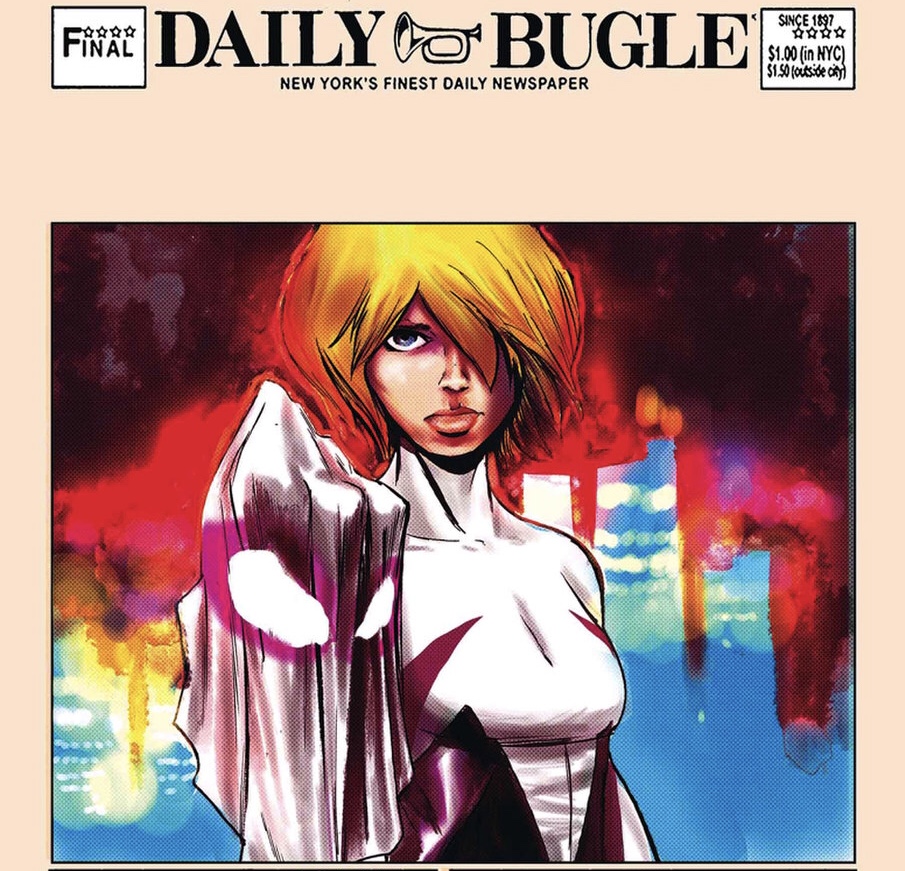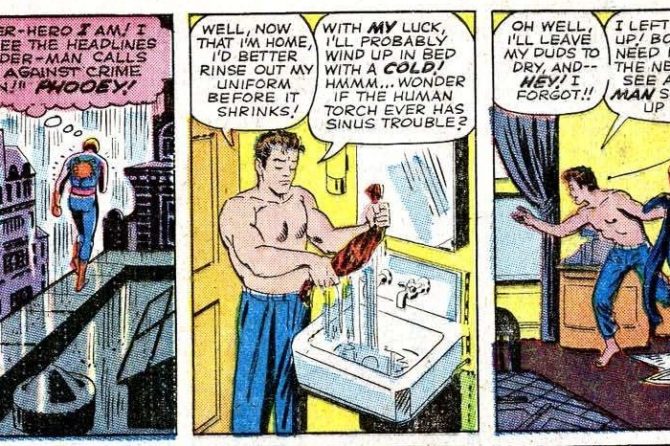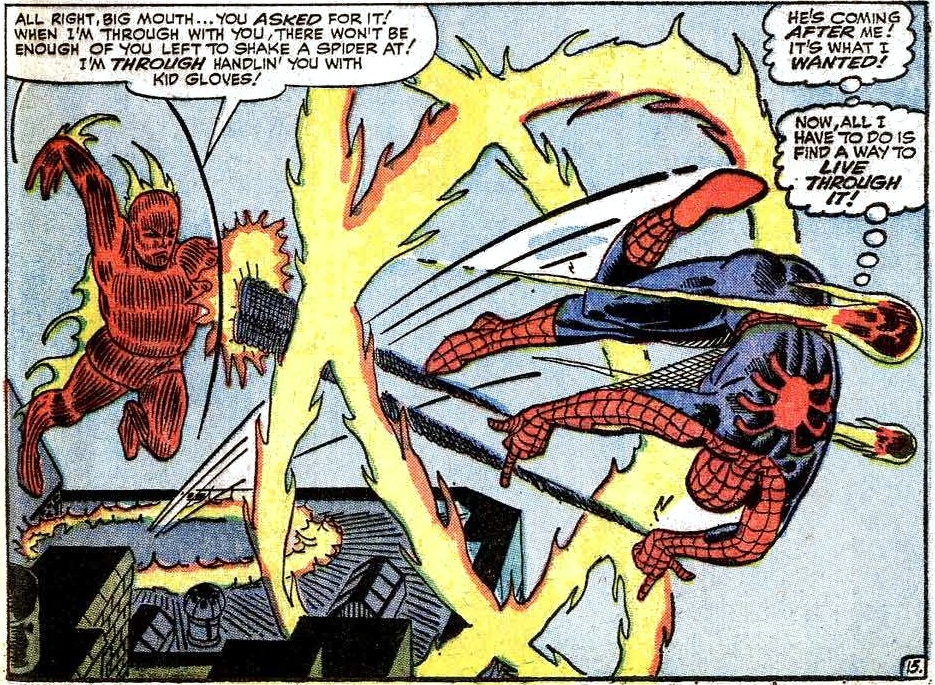And now, for something completely different: a man with the powers of a spider with a very unique choice of wardrobe – Mr. Bug Guy.

Although not all spiders in the animal kingdom are red and blue, Spider-Man’s uniform – not a costume – is right there in the top three list of the most recognizable superhero visuals in pop culture: standing alongside that chap from a dying planet with a big “S” on his chest and cape, and the other with a pathological hatred for criminals with a bat on his armor.
It’s a crucial reminder that Peter Parker’s fashion choice was designed to present himself as an entertainer – not a crime fighter. Hence the need for visual appeal, and of course, to cover his entire body so no one could figure out that the person behind the mask was just a kid from Queens trying to make easy money out of his abilities, pretending to be a man.
As far as originality goes, it is another reason for Spider-Man to remain in this top three list – his origin is unique; the one conceived by its co-creator: Steve Ditko.

Calling him a genius might be still an understatement in the world of the ninth art. Not only because of his most famous creation but also of his sense of design, style, and creativity (Dr. Strange is another). By default, every Spider-Man fan should be familiar with his body of work; there’s nothing in the industry like it. His archives published by Fantagraphics is a great introduction to it.
Regardless of how many different uniforms were made over the years, they were all made from the one single matrix – made by Ditko. It’s iconic, word-wide recognizable, and timeless; to the point that his own uniform becomes the symbol. Still, it’s worth analyzing some of its iterations:

Clothes indeed make the (Spider) Man.
He has the kind of visual reputation that few characters in the superhero comic book industry achieved. And Marvel, thanks to the incredible talents such as John Romita Sr. and Dave Cockrum, maintained the status of having characters that are not only more relatable in their personalities and origins but also iconographic and memorable by their uniforms. For those attributions, Peter Parker, The Amazing Spider-Man stands atop. Also, thanks to Stan Lee and Ditko and their “realistic” approach, the young hero was the first to be shown designing and sewing it.
Exhibit A: Amazing Fantasy #15 – Vol. 1, August 1962.
Part of J. Michael Straczynski’s run in ASM focuses on the growth of the character and how much he’s evolved; it offered a reexamination of the aspects that build him in its entirety – including the uniform. This second intermezzo is part of the epic 500th issue, inviting the reader into Peter’s frame of mind regarding his attire and reveal a glimpse of how some of the uniforms in the Marvel Universe are actually made – in an original fashion.
Intermezzo n. 2: YOU WANT PANTS WITH THAT? – ASM#502 (vol.1 – February 2004):
(Cover by Jason Pearson)
It all starts during dinner. Peter and Mary Jane are at a restaurant, talking about how much they’ve progressed as a couple since their reunion. In their conversation, a plot thread for future stories is tailored: MJ reveals her desire to resume her modeling career. Before he says anything, a car chase passes their window; Peter apologizes for the sudden leave, changes into the friendly neighborhood, and swings after it.
This initial four-page sequence itself is cinematic at its best – John Romita Jr. with Scott Hanna keep delivering the art in its best rhythm. The camera framing and zooming are impeccable – even for a restaurant scene where two people are just talking, switching to a great shot from the viewer’s ground of Spider-Man swinging into action.
But the camera stays on ground level, switching to a certain Leo Zelinsky, who observes the chase from afar and continues his walk to his tailor shop. Inside, he overhears the talk of his customer on the phone – a grunt self-named Killshot -, discussing the details of his next target. Leo gives him his new tailored action/working suit. At dinner, he discusses with his grandson Michael the knowledge that Killshot will assassinate someone; he had probably overheard it too. Leo tries to make his logic sound to Michael – that all he can do in order to guarantee his living as a service provider, is that he cannot interfere, otherwise, they’ll be in danger. Michael then confronts his grandfather with a very simple truth taught by his father, a police officer who perished in the line of duty: The most cowardly thing a man could do is to not get involved when something wrong is being done to someone.
JMS literally rewrites Edmund Burke’s most famous statement (in a letter addressed to Thomas Mercer) that “The only thing necessary for the triumph of evil is for good men to do nothing.” And makes a child say it. It’s like the old adage: power and responsibility; even if the power means knowledge.
Zalinsky’s conscience speaks louder and off he goes walking into the night, searching for that Bug Guy who looks after his neighborhood. As expected, the Bug Guy is found and once more Straczynski takes his time to explain the why of the situation; because the story must be driven by the characters. They are the answer, the source, and the conduit to the chronicle.
Before his “origin story” is presented, Leo Zelinsky asks Spider-Man a question that defines his own character (and the “why” of the tale):
“Who did your costume?”
We hereby invite the reader to examine the evidence.
Exhibit B: The Amazing Spider-Man #4 – Vol. 1, September 1963.

Exhibit C: The Amazing Spider-Man #20 – Vol. 1, January 1965.

Exhibit D: The Amazing Spider-Man #25 – Vol. 1, June 1965.

Exhibit E: The Amazing Spider-Man #27 – Vol. 1, August 1965.

Exhibit F: The Amazing Spider-Man #129 – Vol. 1, February 1974.

The Verdict:

Being a self-made superhero in defense of the locals is being subject to local criticism – wherever is aimed at.
Back to the story: once upon a time, Yancy’s Street favorite son, the blue-eyed Thing needed urgent help to cover his rocky body intimate parts after a battle; Leo Zelinsky’s shop was the closest. The word spread out in the superhero community: that there’s this guy who fixes it for them. Then came Dr. Doom in need to repair his cape – after all, super-villains are also people, and just like food, they need clothing. So the tailor created a system: Heroes on Mondays, Wednesdays and Saturdays; bad guys on Tuesdays and Thursdays. And not only that – he specializes in the creation and development of costumes for both.
He then tells Spider-Man about Killshot’s assassination assignment (the District Attorney), and how it poses a threat to him in case he breaks his confidence as a customer. The hero decides to help and heads home. Still, the conversation stirs him with some (literal) reflections on his uniform:

With the info provided, Spidey intervenes in Killshot’s assassination attempt, but he diverts the hero’s attention by putting an innocent bystander’s life in peril and heads to Leo’s shop. Before the killing shot (pun intended) aimed at Michael, Leo jumps in the way and takes a bullet to the shoulder. Spider-man arrives before the second and webs up Killshot.
As a token of gratitude, he is given a new design for his uniform:

Life happens in circles. The design is for the same costume worn by the alternate future version of Spider-Man as seen in Amazing Spider-Man #500 – reviewed in this post.
Suddenly, that future becomes a possibility.
Besides answering one of the most long-standing unanswered questions in the Marvel Universe (who tailors these people’s clothes?) on what would be considered a light story, Straczynski delivers an impactful cliffhanger. As readers, we become hooked and start to question if this alternate future can come to pass. It’s a suggestion, a glimpse that this might be the very uniform that Peter Parker might die in it. The introduction of Leo Zelinsky in the title may not be accidental, after all. If there’s a web of destiny, it’s under constant weaving.
But the hints don’t stop there. When Peter was detached from time, the possible future he contemplated was the end of his life – he died fighting the police. Regarded as a criminal for something he would have done? Or is this simple tale an omen of the superhuman CIVIL WAR? It could be that in this possible future, the superhero registration act might have had terrible consequences for Spider-Man.
It’s also noteworthy that Marvel comics released from 2003 until 2020 the random series of comics titled THE END – featuring The Hulk, The X-Men, Wolverine, The Punisher, Doctor Strange, Captain America, Iron Man – even Venom. But Spider-Man is not part of it. Probably because of a simple editorial decision: the grittiness of the theme and how each story depicts the actual death of these characters. OR – because Spider-Man had already his “final story” told in Spider-Man: Reign (2007) – by Kaare Andrews -, which unfortunately hasn’t aged well, and is not a light story either; Andrews might (or not) have attempted to make his version of The Dark Knight Returns using the friendly neighborhood hero, using the same plot mold by Frank Miller: an old-aged hero in a bleak future. Few artists are capable to actually write great superhero stories. it’s a shortlist.

Fortunately, there came Chip Zdarsky and presented the readers with a great alternate tale about ‘the end’ of Spider-Man in the great Spider-Man: Life Story (2019), with art provided by the living legend of Mark Bagley. Instead of presenting the future of the hero, Zdarsky simply made the hero grow old in real-time since his official birth in 1947, to become the hero in 1962 and get older until the second decade of the 21st century. It’s a well-crafted, heartwarming tale and a love letter to the character – deserved of high praise.
By the same premise, Straczynski himself wrote one of his most beautiful stories for the medium in Silver-Surfer: Requiem (2007) – a tale that deserves a review of its own, depicting the death of Norrin Radd; drawn by Esad Ribic. Mandatory reading.
Superhero comic books often explore, revisit, change and extrapolate their timelines. The depiction of their older selves is nonetheless a great exercise of the imagination for both writers and readers. And despite the stories in which depict their demise or sacrifice (there are just so many of them), they outlive the generations of readers who saw them published for the first time and will continue to do so. Their uniforms might evolve with time, but never changed, no matter how hard it’s tried; original concepts cannot be simply redefined; because the way they look is also part of their mythological legacy.
And visually, Spider-Man is also his uniform. It enhances his superhero persona. It embodies the symbol he represents. It’s one of the reasons why he’s so revered. Simply put, amazing.












@Adam Schingle: thanks for the correction, man: how could I ever miss that!? Thanks for reading it.
@Aqu@ & Sthenurus: thank you so much for your comments and remarks; you make the research and the writing process worthwhile.
Another enjoyable article. A minor correction: Exhibit A is from Amazing Fantasy #15.
Ah, I have to add that, having tried manually sewing (parts of) a costume myself, it’s impressive how Peter’s suit didn’t come out all crooked. And he still has the guts to say he is no “cotton-pickin’ seamstress”! The guy!
A little late, but here I am!
I already stated how that “future Spider-Man” costu-ehm-… suit is one of my favorite. If anything, because of the practicability.
I loved Life Story, it’s really the sum of Spider-man’s life and adventures. I’ll admit I was touched by the ending.
The fact that Peter made his own costume has always been some sort of obstacle when transposing his epic to the big screen, especially because it’s not easy to do justice to his iconic suit without giving the impression it’s a pajama.
Raimi’s trilogy did a great job at creating a good suit visually, but glissed over how a teenager could have realized something that complex.
The Amazing Spider-Man had a terrible feel for the texture, seemingly made up of basketballs, and still didn’t make the making by a teenager looking plausible. At least TASM 2 had a faithful look (the only thing I liked about the movie, but I digress), apart from the spider on the back.
As of today, the MCU version is the best: Peter did make up a costume with clothes (not sewing it, however) and while it looked quite a bit like Scarlet Spider, it was realistic. Then the classic suit is not done by him, but by an adult with access to technology. And visually it remained classic but feeling modern at the same time, with a touch of realism.
As usual, great insightful article!
Where can we get that poster? it’s absolutely amazing.